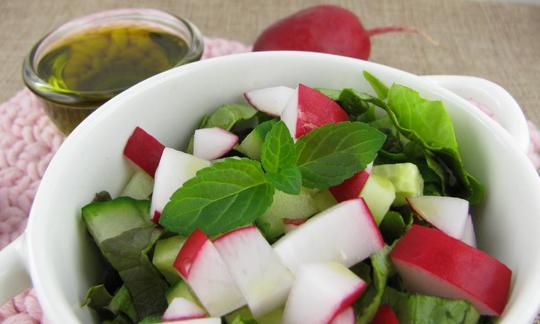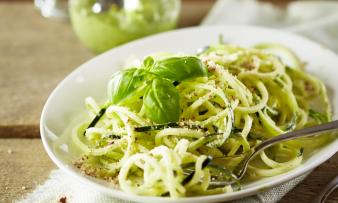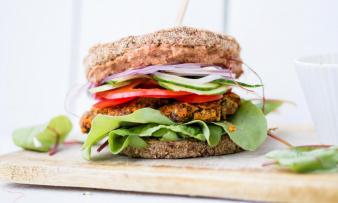Hemp oil consists of pressed hemp seeds and does not contain any significant amounts of the psychoactive ingredient tetrahydrocannabinol (THC). It has many uses in the kitchen and its fatty acid spectrum contains all the essential fatty acids that are important for humans.
Use in the kitchen:
The hemp oil has a wonderful nutty taste and is particularly tasty when used as cooking oil for salads, in dressings, marinades, sauces or spreads. If it is made from unpeeled hemp seeds, it can have a slightly bitter aftertaste. It is still suitable for stewing and steaming, but should definitely not be used for frying or deep-frying. At higher temperatures (smoke point is 165 °C) the fatty acids decompose and can change the taste of the oil.
| Not only vegans or vegetarians should read this: Vegans often eat unhealthily. Avoidable nutritional mistakes. |
Purchasing:
Hemp oil "extra virgin" is cold-pressed and unrefined, this should be used as cooking oil. The darker the color, the more intense the hemp taste. To avoid contamination with pesticides, you should always use organic hemp oil.
Cold-pressed oils (laws, raw food)
In Switzerland, oil is referred to as cold-pressed oil if the oilseed was not heated, the pressing temperature did not exceed 50 °C and no problematic post-treatment took place.
According to the Federal Department of Home Affairs ( FDHA), an edible oil is considered cold-pressed (or may be described with synonyms such as (extra) virgin, unrefined, cold-pressed or natural) if it has been obtained by pressing or centrifuging from previously unheated raw materials, the temperature during pressing did not exceed 50 °C and it has not been subjected to refining, i.e. no neutralisation, no treatment with adsorbents, bleaching earth or steaming.
An oil may be described as “gently steamed” if the refining process was limited to steaming and the temperature did not exceed 130 °C. 3
In the EU and the USA, there does not appear to be a generally applicable temperature limit set by law for cold-pressed oils. For example, the guidelines for edible fats and oils of the Federal Ministry of Food and Agriculture (D) are written in a similar way to the EDI regulation, but they do not specify a permissible maximum temperature for general cold pressing - since they only apply to products whose labelling and composition are not conclusively set by law (i.e. not for olive oil, cocoa butter, milk fats, spreadable fats, for example). 4
On the other hand, both the EU directives and the amendment to the EDI regulation on foods of plant origin, mushrooms and table salt (and its amendment) provide for a special rule for the labelling of olive oils. 5,6
These are selective marketing rules in which the term raw food is not defined. "Raw food" and "raw" are therefore not state-protected terms (as is the case with the term "organic"), which leaves a lot of room for interpretation. Although it is agreed that with purely mechanical cold pressing, the pressing temperatures generally do not exceed 40 °C, one should not naively assume that cooking oils are raw food quality. There is a suspicion that the measuring method used does not indicate the temperature in the press cylinder (where the heat is highest), but only the outlet temperature in the oil hose. With water-cooled olive oil presses (so-called "water-cooled 37°" oil presses), one probably cannot even say with certainty what the exact temperature is inside the press cylinder, because the entire press cylinder is surrounded by cooling sleeves.
In addition, the pressing pressure and speed as well as the moisture content of the oilseed affect the pressing temperature. If, for example, the moisture content is too low, the temperature rises during pressing and it is difficult to stay even below the maximum limit of 50 °C. 7
Storage:
Because of its high content of unsaturated fatty acids, it should be stored in a cool, dark place and tightly closed; preferably in the refrigerator, then it will last for up to a year.
Ingredients:
The hemp seeds contain vitamin E, calcium, magnesium, potassium and iron. The proportion of vitamin B, especially B1 and B 2, is relatively high. The seeds contain all eight essential amino acids for humans, making them particularly suitable as a source of protein. They contain proteins such as globulin edestin and are very easy to digest, but the low lysine content limits the protein value. 1
The hemp oil is extremely high quality because it contains around 80% polyunsaturated fatty acids, especially the essential linoleic and alpha-linolenic acid. It also contains γ-linolenic acid, oleic acid, palmitic acid, stearic acid, gadoleic acid and stearidonic acid. During the pressing process, chlorophylls and carotenoids are released, which are also responsible for the color. It also contains relatively large amounts of tocopherol and phytosterols.
The ratio of the polyunsaturated fatty acids Omega-6 and Omega-3 is approximately 2.8:1. This refers primarily to the essential linoleic acid (Omega-6) and alpha-linolenic acid (Omega-3). For comparison: cold-pressed linseed oil has a ratio of 1:3.7, cold-pressed rapeseed oil 2:1 and olive oil 11.5:1. More on this in the article: Vegans often eat unhealthily. Avoidable nutritional errors.
Regardless of the variety, hemp seeds do not contain THC ( tetrahydrocannabinol) or other intoxicating ingredients.
You can find all the ingredients, the coverage of the daily requirement and comparison values with other ingredients in our nutrient tables. In the article Nutrients explained you will get a detailed insight into the topic.
Use as a medicinal plant:
In general, it has an anti-inflammatory effect and is therefore used in medicine to treat ear, nose and throat infections and inflammatory skin diseases.
General information:
Hemp oil is a fatty vegetable oil pressed from the seeds of industrial hemp ( Cannabis sativa). It should not be confused with essential hemp oil, which is distilled from leaves and flowers. There is also hashish oil, a resin extract from hemp resin, which has a very high THC content.
The hemp seeds are cleaned after harvesting and pressed in an oil mill to make hemp oil. With cold pressing, the pressing temperature is between 40 and 60 °C, which is the gentlest for the ingredients contained. The color of the oil is then green-yellowish - if it is pressed warm, the color can be dark green.
Hemp oil is also very important in the cosmetics industry; it is contained in massage oils, ointments, creams, soaps and shampoos. In addition, it is still used in the Orient as lamp oil because it burns particularly brightly. Since it is considered to be easily biodegradable, hemp oil is also used to make cleaning products.
Press residues from oil production also serve as high-quality animal feed.
Literature - Sources:
Bibliography - 6 Sources
| 1. | House J, Neufeld J, Leson G. Evaluation the quality of protein from hem seed (Cannabis sativa L.) products through the use of the protein digestibility-corrected amino acid score method. Journal of Agricultural and Food Chemistry. 2010 November 58; (22):24. doi:10.1021/jf102636b. PMID 20977230. |
| 3. | Verordnung des EDI über Speiseöl, Speisefett und daraus hergestellte Erzeugnisse vom 23. November 2005 (Stand am 1. April 2008), Art. 3a und 3b. |
| 4. | bmel.de Leitsätze für Speisefette und Speiseöle. Neufassung vom 02.07.2020 (BAnz AT 18.08.2020 B3, GMBl 2020 S. 530). |
| 5. | Amtsblatt der Europäischen Union. Durchführungsverordnung (EU) Nr. 29/2012 der Kommission vom 13. Januar 2012 mit Vermarktungsvorschriften für Olivenöl. Artikel 5 a) und b). 14.1.2012. |
| 6. | EDI Eidgenössisches Departement des Innern. Verordnung des EDI über Lebensmittel pflanzlicher Herkunft, Pilze und Speisesalz (VLpH). Änderung vom 8. Dezember 2023. Inkrafttreten: 1. Februar 2024. |
| 7. | Schaufler D. Oilseed Fact Sheet: Oilseed Presses. Dept. of Agricultural and Biological Engineering, Penn State College of Agricultural Sciences. |










Comments